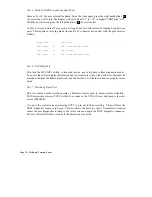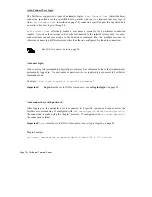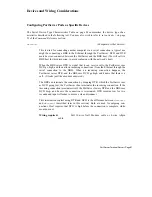
PortServer Terminal Server
Ÿ
Page 81
Devices and Wiring Considerations
Configuring PortServer Ports as Specific Devices
The Serial Device Type Characteristics Table on page 84 summarizes the device type char-
acteristics described in the following text. You may also wish to refer to set ports dev= on page
51 of the Command Reference section.
dev=host
(Computer or other devices)
This is used for connecting another computer via a serial connection; a typical use
might be connecting a BBS to the Ethernet through the PortServer. DCD and DTR
must be cross-connected between the PortServer and the BBS host. (We will call it a
BBS host for this discussion, to avoid confusion with the network’s host.)
When the BBS raises DTR to signal that it can receive calls, the PortServer sees
DCD go high, and then allows incoming connections (from the Ethernet through the
serial connection to the BBS). When an incoming connection happens, the
PortServer raises DTR, and the BBS sees DCD go high, and knows that there is a
call. (It looks just like a modem answered.)
The BBS can terminate the connection by dropping DTR, which the PortServer sees
as DCD going low; the PortServer then terminates the incoming connection. If the
incoming connection terminates itself, the PortServer lowers DTR and the BBS sees
DCD drop, and knows the connection is terminated. DTR remains low for two
seconds and input is flushed to assure a clean disconnect.
This termination control using DTR and DCD is the difference between
dev=host
and
dev=mout
(described later in this section). Both are used for outgoing con-
nections. Host requires that DCD is high before the connection is complete, while
mout does not.
Wiring required:
Full 10-wire Null Modem cable or 8-wire Altpin
cable
















































